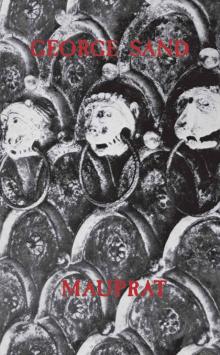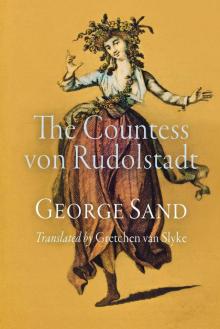- Home
- George Sand
The Countess von Rudolstadt
The Countess von Rudolstadt Read online
The Countess von Rudolstadt
The Countess von Rudolstadt
George Sand
Translated by Gretchen van Slyke
Copyright © 2008 University of Pennsylvania Press
All rights reserved. Except for brief quotations used for purposes of review or scholarly citation, none of this book may be reproduced in any form by any means without written permission from the publisher.
Published by
University of Pennsylvania Press
Philadelphia, Pennsylvania 19104-4112
10 9 8 7 6 5 4 3 2 1
A Cataloging-in-Publication record is available from the Library of Congress
ISBN: 978-0-8122-2014-8
Contents
Introduction
Chapter I
Chapter II
Chapter III
Chapter IV
Chapter V
Chapter VI
Chapter VII
Chapter VIII
Chapter IX
Chapter X
Chapter XI
Chapter XII
Chapter XIII
Chapter XIV
Chapter XV
Chapter XVI
Chapter XVII
Chapter XVIII
Chapter XIX
Chapter XX
Chapter XXI
Chapter XXII
Chapter XXIII
Chapter XXIV
Chapter XXV
Chapter XXVI
Chapter XXVII
Chapter XXVIII
Chapter XXIX
Chapter XXX
Chapter XXXI
Chapter XXXII
Chapter XXXIII
Chapter XXXIV
Chapter XXXV
Chapter XXXVI
Chapter XXXVII
Chapter XXXVIII
Chapter XXXIX
Chapter XL
Chapter XLI
Epilogue
Letter from Philon1 to Ignatius Joseph Martinowicz Professor of physics at the University of Lemberg
Notes
Acknowledgments
Introduction
While this is not the first English translation of George Sand’s La Comtesse de Rudolstadt, it is the first in over a hundred years,1 and I feel that it is high time to make Sand’s great novel about love and revolution once again available to readers for whom the original French might prove daunting.
George Sand (1804–76) began working on La Comtesse de Rudolstadt, one of her most ambitious, engaging novels, when she was some twelve years into her long and productive career as a novelist. A hefty tome even by nineteenth-century standards, La Comtesse de Rudolstadt is merely the last part (but one that stands alone remarkably well, as readers will see) of Sand’s monumental novel entitled Consuelo. This work started out as a short story about the formative years of a fictional Venetian street singer, the daughter of a Spanish Gypsy, whom the great maestro Porpora discovered and trained for the opera. Sand modeled her eighteenth-century heroine in part on the opera singer Pauline Garcia Viardot, who made her Parisian début at age eighteen in October 1839 and promptly excited Sand’s admiration because of her voice, her musicianship, and the rare qualities of her person. In June 1842, Sand wrote to Viardot, whom the author had now taken on like another daughter, “You are the priestess of the ideal, and it is your mission to cast it far and wide.”2 Fed by Sand’s rich imagination and bold aspirations for social reform, the little sketch swelled into a sinuous novel of initiation drawing on such diverse models as Ann Radcliffe’s Gothic tales and Goethe’s Wilhelm Meister.3
In the first part of the long novel, Consuelo suffers betrayal at the hands of the childhood love to whom she was betrothed and suddenly leaves Venice for the depths of Bohemia, where the Hussite wars of religion had raged in the fifteenth century and still resonated in the hearts and minds of many of its people. It is there that Consuelo takes refuge among an aristocratic family and that Albert, the last descendant of the proud Rudolstadt line, falls in love with her. Despite her admiration and affection for Albert, she cannot wholeheartedly return his love, nor does she want to sacrifice her brilliant operatic career to marriage. Finally, when Albert is near death from some mysterious wasting disease, she agrees, out of a sense of compassion, but not without feelings of sorrow and dread, to become his wife. At the end of Consuelo, Albert dies, and La Comtesse de Rudolstadt follows the life of the young widow after her return to the stage in Vienna and Berlin, two great capitals of musical culture and political might in mid-eighteenth-century Europe. Now entirely free to pursue her career, she sinks deep into depression, tormented by the thought that her inability to love Albert contributed to his death and wondering how to reconcile the demands of her profession, of her heart, and of her conscience.
Consuelo’s peregrinations manifest a quest undertaken on a number of levels: as a singer, as a woman, and as an unwilling subject of alienation and oppression. The worlds through which Consuelo moves are bewilderingly complex, where authoritarian rulers like Frederick the Great mingle with Enlightenment philosophers, sorcerers, charlatans, where secret societies are conspiring to change the world. The old order of political absolutism and female subjugation is beginning to crack, and Consuelo will undergo various ordeals and grueling initiations into radically redefined notions of social organization, including the place of women in marriage, the family, and the nation. While many of these promises remain unfulfilled in the course of Consuelo’s life, they never cease to act as beacons of hope for the heroine of the novel, and for the author as well. Written some fifty years after the French Revolution, Sand’s novel taps into many of the deep philosophical and religious currents that contributed to that staggering social upheaval, all the while aiming to channel their potential for the revolutions that will continue to work toward the realization of these ideals.
This time and these places are no gratuitous choices on the author’s part. Sand was clearly fascinated by the eighteenth century, which she characterizes as “this enormous logogriph, this brilliant nebula, where so much cowardliness contrasts with such grandeur, so much knowledge with such ignorance, so much barbarism with such civilization, so much enlightenment with such errors, so much seriousness with such intoxication, so much unbelief with such faith, so much learned pedantry with such frivolous mockery, so much superstition with such proud reason. . . . A terrifying laboratory where so many heterogeneous forms were thrown into the crucible that their monstrous ebullition belched forth a torrent of smoke through which we are still marching, enveloped in darkness and confusion.” In another use of this laboratory metaphor, Sand presents eighteenth-century Europe as “teeming with secret societies, underground laboratories where a great revolution, whose crater will be Germany and France, is being prepared.” Drawing up a long catalogue of secret societies whose historical existence bears no doubt, Sand goes on to invent an even more secret society that will go by the name of the Invisibles and function as the missing link to the Illuminati of Bavaria. To Pierre Leroux, a socialist philosopher and one of many friends who provided her with documentation about various secret societies and underground political associations, she justified this leap by grumbling that imagination alone could fill out the little that could actually be learned about them. Sand was convinced, moreover, that their “heresies,” as she called them, constituted “humanity’s occult history,” a matter merely adumbrated in official history and requiring in-depth work.4
Feeding her contemporaries’ fascination as well as her own for such arcane conspiracies, her text abounds with stories about the terrifying works and shadowy origins of these mysterious characters. Sand’s Invisibles are finally revealed as a covert army of philosophers and ref
ormers who risk proscription, poverty, imprisonment, and death to pursue their goals. A supersecret society that remains carefully concealed from other secret societies, such as the Freemasons and Rosicrucians, the Invisibles stealthily work to achieve control of the latter and to use them as a “nursery out of which [to] choose the strong seedlings destined for transplantation in the sacred forest.” In other words, for the nonviolent mission of regenerating society through a radical religious and philosophical understanding of the ideals that would become the watchwords of the French Revolution.
What is the source of the Invisibles’ doctrine? They explain to Consuelo that their beliefs are a set of religious and political ideals that the Roman Catholic Church time and time again has condemned as heresy and endeavored to eradicate—tidings of evangelical equality that were revealed to the apostles of early Christianity and passed on down through history by the likes of John Wyclif in England, Jan Hus in Bohemia, and Martin Luther in Germany, and that would again erupt as the spirit of revolution in late eighteenth-century France. In the words of one of Consuelo’s initiators, “Liberty, fraternity, equality: this is the mysterious, deep formula of the work of the Invisibles.” While these words may seem hollow and trite to twenty-first-century readers who see them as little more than a decorative inscription on French monuments, in France of the 1840s they either harked back to the bloody miscarriage of the Revolution of 1789 or beckoned to its still unfulfilled promise; and in Consuelo’s Europe these words were considered so new, dangerous, and untenable that they could be revealed only to the highest initiates of the Invisibles and only after lengthy and careful preparation.
One of Sand’s inspirations for the Invisibles was the polemic written by the Jesuit Abbé Augustin Barruel, Mémoires pour servir à l’histoire du jacobinisme, first published in 1797. Barruel argued that the French Revolution was the result of a conspiracy planned and executed by various secret societies in accordance with their desires to destroy monarchies as well as the Roman Catholic Church. When he reported in tones of abomination that the Freemasons’ secret consisted in the words liberté, égalité, fraternité, Sand seized upon this detail with great enthusiasm. When Barruel blamed the Freemasons and the Illuminati of Bavaria for the French Revolution and traced the coming cataclysm back through the history of heresy, Sand would essentially repeat the same gesture, only replacing Barruel’s shudders of horror with bounding enthusiasm. Indeed, her Invisibles, coming from a long line of predecessors, would pass on to the Illuminati of Bavaria “something like an electric current of sublime enthusiasm, ardent faith and terrible fanaticism,” which they would in turn communicate to the French Revolution.
For Sand, and for the Invisibles as well, the word “heresy” carried an entirely positive meaning, and during her initiation Consuelo will hear these words out of the spokesman for the Invisibles: “At bottom, all heretics (I use this word with respect) agree on the main point, which is to destroy intellectual and material tyranny or at least to protest it.” It must also be noted that Consuelo and La Comtesse de Rudolstadt show a particular fascination with the Taborites as well as all the Hussite factions in fifteenth-century Bohemia. This is so because Sand saw their protests in the name of equality and their war cry “The chalice for the people!” as an early formulation of the ideals of the French Revolution. As she explains in a companion volume distilling her research on the Hussites,5 their bid for religious freedom from the Roman Catholic Church and political freedom from the Holy Roman Empire illustrates yet another chapter in the long struggle between the people’s aspirations to evangelical equality, on the one hand, and the powerful hierarchies of church and state, on the other:
Official religion, the established Church, has always followed the same system; the secret religion, the one still seeking to establish itself, this ideal society of equality, which begins with the sermons of Jesus, goes through centuries of Catholicism under the name of heresy, and leads here to the French Revolution, then takes a new shape and is subject to debate, for lack of anything better, in chartist societies6 and hotbeds of communism,—this religion too is always the same, no matter what form it has taken, no matter under what name it has veiled itself, no matter what persecution it has endured. . . . Heresy in the past, socialism today, this is the shriek of the starving entrails and desolate hearts that call for true knowledge, the voice of the spirit, the religious, philosophical and social solution to the monstrous problem suspended over our heads for so many centuries. This is what heresy is, and nothing else: an idea essentially Christian in its principle, evangelical in its successive revelations, revolutionary in its endeavors and demands; and not a sterile quarrel over words, an overweening interpretation of the sacred texts, a suggestion of the Satanic spirit, a need for vengeance, adventure and vanity, as it has pleased the Roman church to define it in its indictments and denunciations. (38–40; my translation)
This militant faith and philosophy of history, which could be viewed as an early version of liberation theology, was inspired in good part by Pierre Leroux; and during the years that Sand spent writing Consuelo and La Comtesse de Rudolstadt, her letters bear frequent witness to the ways in which Leroux’s thought transformed her life, bringing her out of despair and providing a system of belief far more satisfying to her than her childhood Catholicism. With regard to Leroux she wrote to a young poet in February 1843:
as it is the only philosophy that is as clear as day and speaks to the heart like the Gospels, I plunged into it and was transformed. I found in it the calm, the strength, the faith, the hope and the patient, persevering love of humanity, the childhood treasures of which I had dreamed in Catholicism, but which had been destroyed by the examination of Catholicism, by the inadequacy of the obsolete cult, by the doubt and affliction that devour, in our times, those who haven’t been besotted or warped by egotism and well-being. . . . In short, it is a whole religion both ancient and modern, and one needs to steep oneself in it, to incubate it tenderly.7
Pierre Leroux (1797–1871), a typesetter by profession, was part of the underground republican movement known as the Carbonari at the end of the Bourbon Restoration. After brief association with the Saint-Simonian sect in the early 1830s, he went on to form his own theories of community while continuing to play an influential role as a literary critic and philosopher. His major works, none of them translated into English, are De l’Égalité (1838), La Réfutation de l’éclectisme (1839) and De l’Humanité (1840), in addition to the popular Encyclopédie nouvelle (1838–41), which he coedited with Jean Reynaud. George Sand met Leroux in 1835, dedicated to him her 1839 novel Spiridion, and drew on his inspiration while composing Consuelo and La Comtesse de Rudolstadt, with significant parts of the latter work (especially chapters 31, 32, 38, 41, and 43) acting as introductions to various aspects of Leroux’s thought. From February 1842 through February 1844, Consuelo and La Comtesse de Rudolstadt were published as installments in La Revue Indépendante, which Sand had recently founded with Leroux and Louis Viardot (Pauline Viardot’s husband) for the diffusion of reformist ideas.
Despite Leroux’s influence in France in the 1830s and 1840s, it has been customary among historians for well over a century to dismiss him as a woolly-minded aberration, largely because of his highly abstract and nebulous lucubrations. It should therefore give us pause that Heinrich Heine considered him one of the greatest philosophers of France, while another of Leroux’s contemporaries, none other than Honoré de Balzac, portrayed him in his Illusions perdues as a profound philosopher and bold theoretician, always great, even in his errors. In order to give social reformers such as Leroux their due, some recent scholarship has endeavored to view them in their intellectual context—Paris in the 1840s—where mystical, socialist, republican, and feminist feeling came together in various strains of romantic socialism, so very different in mood, method, and aim from the so-called scientific socialism of the post-Marx era.8 Although Romantic socialism failed to effect the broad reforms that it envisaged for mid-ni
neteenth-century society, it did make remarkable contributions to the political and literary discourse of the time.
Romantic socialism was not primarily an attack on private property or even capitalism, but a varied set of responses to the philosophy of the Enlightenment, to the 1789 Revolution, especially the bloody violence that soon engulfed its lofty promise, and to rapid socioeconomic change in the postrevolutionary period. Focusing on the moral and spiritual dimension of human existence, Romantic socialism challenged the principles of individualism upon which the liberal order of politics and economics was founded and lamented the isolation of the beings that this philosophy abandoned to the social struggle for survival. Leroux, along with many other Romantic socialists, judged that this concentration upon reason, individual rights, and economic competition had managed to destroy any real sense of community.
On the other hand, Leroux condemned socialist theories that would override the individual and make the community the sole repository of rights and privileges. Eager to avoid both errors, Leroux defined individuals in terms of what they had in common with their fellows rather than by the differences that set them apart, thereby upholding the individual while neutralizing the basic tenets of individualism. Leroux also insisted on redefining mankind in terms that he found more accurate than those of the rationalist tradition. Man was not just sensation and reason, but also sentiment: these three being as indivisibly united as the Trinity. Appealing to the powers of sensation, sentiment, and reason, Leroux aimed to convert his fellows to what he called the religion of Humanity, a new faith that he presented as a return to the spirit of primitive Christianity, as it was before its betrayal and perversion by the Roman Catholic hierarchy. Although Leroux drew on a wide variety of religious and philosophical traditions, his ideal social structure owed a great deal to early Christian communities, which he took as living demonstrations of the true meaning of liberté, egalité, fraternité. All the while inveighing against the power structure of the Roman Catholic Church, he endeavored to revitalize Christian spirituality so as to give society a sense of community and to put economic and political relationships on a footing of love and solidarity.

 Lelia
Lelia Mauprat
Mauprat Valentine
Valentine The Countess von Rudolstadt
The Countess von Rudolstadt Laura
Laura Indiana (Oxford World's Classics)
Indiana (Oxford World's Classics)